Improvement of the High Temperature Wear Resistance of Laser Cladding Nickel-Based Coating: A Review
Abstract
1. Introduction
2. Ceramic Phase
2.1. WC
| Ref. | Substrate | Matrix | Ceramic Phase | Key Findings | Tribological Testing Process, Parameters |
|---|---|---|---|---|---|
| Zhou, 2011 [26] | 1Cr18Ni 9Ti | NiCrBSi | WC | Coatings produced by supplementing WC powder with NiCrBSi display greater high temperature abrasion resistance than NiCrBSi coatings | A THT07-135 pin-on-disk tribometer; Si3N4 ball (diameter 6 mm); Load: 5 N; Temperature: 25, 500 °C; Sliding speed 300 mm/s; Sliding distance: 500 m |
| Guo, 2010 [30] | pure Ti discs | NiCrBSi | WC | Under similar circumstances, the abrasion rate of the NiCrBSi/WC-Ni composite coating is around 24–47 times lower than that of the pure Ti substrate | A THT07-135 pin-on-disk tribometer; Si3N4 ball (6 mm). Temperatures: 300 °C, 500 °C; Load: 5 N; Sliding speed: 300 mm/s; Sliding distance: 500 m |
| Wang, 2013 [31] | 4Cr14Ni14NW2Mo | NiCrBSi | WC, CeO2 | Ni21 + 20%WC + 0.5%CeO2 coating microstructure was effectively refined and the coating presented a relatively well-abrasive behavior | A MG-200 high speed and temperature wear test machine. Grinding ring: heat-resistant cast iron; Temperature: RT (Rome temperature), 250, 450 and 650 °C; Load: 300 N; Velocity: 25 r/s; Load time: 3~3.5 min |
2.2. TaC
2.3. Other Ceramic Phase
| Ref. | Substrate | Matrix | Ceramic Phase | Key Findings | Tribological Testing Process, Parameters |
|---|---|---|---|---|---|
| Zang, 2015 [38] | 20Cr2Ni4A | Ni45 | NiCr-Cr3C2 | NiCr–Cr3C2 coating has a better abrasive rate and lower COF | A ball-on-plate friction test; Temperatures: 20, 100 and 300 °C using; SiC ball (d = 10 mm); Load: 3 kg; The stroke: 1000 μm; frequency: 50 Hz Time: 30 min |
| Guo, 2013 [40] | pure Ti discs | NiCoCrAlY alloy powder | ZrB2 | The addition of ZrB2 as a hard ceramic phase to support and protect the substrate during the wear process, resulting in only slight wear marks on the surface in the friction test | A SRV-IV friction and wear tester. Si3N4 balls (d = 1 cm); Temperature: 20, 100, 300 and 500 °C; Load: 40 N; frequency: 15 Hz; Time: 15 min |
| Sun, 2022 [41] | Q235 low carbon steel | Ni60AA | Cu, CuMo, CuMoW | The additive of Cu refines the organization of the coating and results in the formation of NiCu solid solution. Resists wear and lubrication | MMQ-02G; The zirconia ball (4 mm); Temperature: RT, 600 °C; Time: 30 min; Load: 30 N; Frequency: 1 Hz |
3. Solid Lubricants
3.1. Lamellar Solids
| Ref. | Substrate | Matrix | Ceramic Phase | Key Findings | Tribological Testing Process, Parameters |
|---|---|---|---|---|---|
| Torres, 2018 [50] | stainless steel | NiCrBSi | MoS2, WS2, Ag, Cu | The high temperature wear resistance of the coating decreases after the addition of Cu and Ag | AISI 52,100 bearing balls with a diameter of 10 mm; Load: 50 N. Temperature: RT, 150, 300, 400, 600 °C; Wear time: 900 s; Stroke length: 2 mm |
| Kumar, 2023 [51] | stainless steel | NiCrBSi | Ni3S2, CuS, Bi2S3 | The coating retains high hardness at high temperatures, but the friction coefficients all become unstable | Ball-on-plate configuration; Load: 50 N; Frequency and stroke: 25 Hz and 0.2 cm; Sliding speeds of 10 cm/s. Time: 900 s; Temperature: 25, 400, 600 °C |
| Dilawary, 2018 [54] | AISI 4140 steel | NiCrBSi | Mo | MoO2 can not only enhance the hardness but also act as a solid lubricant to decrease the wear coefficient of the coating | A ball-on-disc configuration; Load: 3 N; Contact pressure: 1.0 GPa; Temperatures: RT, 300, 500 and 700 °C |
| Sun, 2022 [41] | Q235 | Ni60AA | Cu, CuMo, CuMoW | Mainly due to the fine and uniform microstructure and the formation of NiCu solid solution phase, the coating with the addition of Cu exhibits excellent wear resistance | MMQ-02G; The zirconia ball with a radius of 4 mm; Temperature: RT, 600 °C; Time: 30 min; Load: 30 N; Frequency: 1 Hz |
| Liu, 2021 [56] | 304 stainless steel | Ni60 | Ti3SiC2 | Ti3SiC2 synergizes with Ni60 oxide film for better lubrication performance at high temperatures | Si3N4 ball (diameter: 5 mm); Load: 5 N; Time: 30 min; The rotation velocity is 560 r/min. Temperature: 25, 600 °C |
| Ref. | Substrate | Matrix | Ceramic Phase | Key Findings | Tribological Testing Process, Parameters |
|---|---|---|---|---|---|
| Zhang, 2019 [60] | Ti6Al4V | Ni60 | h-BN | The h-BN particles were decomposed to synthesize TiB and TiN in situ in the melt pool to resist wear. The metal oxides produced at high temperatures act as a lubricant | A ball-on-disk type friction and wear test machine; Si3N4 ceramic balls of Φ 6 mm; Rate: 5 Hz; Load: 5 N; Duration: 60 min |
| Lu, 2016 [61] | Ti6Al4V | NiCrBSi | h-BN | Most of the h-BN decompose to produce TiB2, which boosts the hardness of the coating. The residual h-BN acts as a lubricant during friction | A ball-on-disk tribo-meter; Temperature: 20, 300, 600 °C; The counter-body was a Si3N4 ceramic ball (d = 4 mm); Duration: 30 min |
| Zhang, 2008 [62] | 1Cr18Ni9Ti | Nickel powder | h-BN | At lower temperatures, coating wear resistance increases with increasing temperature; in the range of 600–800 °C, coating wear resistance decreases due to the decrease in hardness. | A GWY-2000 ball-on-disc friction and wear tester; Si3N4 ceramic (d = 10); Load: 100 N; Sliding speed: 0.226 m/s; Duration: 20 min |
| Liu, 2020 [63] | TC4 | Ni60 | TiN, WS2 + h-BN | The addition of WS2 + h-BN and TiN increased the average microhardness of the coating by 1.3–1.7 times, and the friction coefficient of the coating was stable | A pin-and-disc friction and wear tester. Duration: 30 min; Load: 50 N, the speed was 100 rpm, the grinding radius: 3 mm. WC ball (d = 9.5 mm) |
| Zhao, 2021 [67] | Q235 | Ni60 | Cu/h-BN + MoO3 | The breakdown of c-BN boosts the bond strength between Cr(Mo)B and the substrate. At the same time, h-BN provides a low coefficient of friction over a broad range of temperatures | A dry sliding pin-on-disk device. Al2O3 balls (d = 5 mm); load: 3 kg; rotating speed: 50 rpm; The rotation diameter 0.1 cm; friction duration: and 0.5 h |
| Liu, 2022 [70] | 45# steel | Ni60 | Cu | Cu plays the friction transfer film and oxidation double-layer self-lubrication. Ni60-5 wt.%Cu composition of the coating, the coefficient of friction at 600 °C is 0.267 | High temperature tribometer with Si3N4 ceramic balls on disk using Φ 6 mm; load: 5 N; time: 30 min; temperature: RT, 600 °C. |
3.2. Soft Metals
4. Conclusions
- (1)
- The wear resistance of the coating is highly correlated with the hardness. The addition of a hard ceramic phase can make the coating maintain a relatively high hardness under the high temperature condition and thus boost the high temperature wear resistance of the coating. Compared with a wide variety of added phases at room temperature, the hard ceramic phase added to enhance high temperature wear resistance is relatively single. The improvement effect of a large number of hard ceramic phases on high temperature wear resistance is yet to be explored. Future work could revolve around a wider range of hard ceramic phases to improve the high temperature wear resistance of coatings. At the same time, the synergistic effect of various hard phases can be studied. In addition, the effects of an electric field, magnetic field, vibration and other auxiliary treatments on high temperature wear resistance of nickel-based coatings can be systematically studied.
- (2)
- The interplanar cohesive bonds between the lamellar solid surfaces are weak, and the lamellar structure plays a self-lubricating role under low shear stress conditions. Soft metal’s own low shear strength and strong ductility in the relatively hard contact surface form a thin layer of soft friction layer. These two types of solid lubricants in high temperature conditions can play a useful role in improving the wear resistance of nickel-based coatings.
- (3)
- The existing lubricant takes effect in a narrow range, and the wear resistance of the coating decreases remarkably after exceeding the applicable temperature range. Future solutions: one is to develop new high temperature lubricating materials with better lubrication effect and wider temperature ranges. The other is through the synergistic effect of multiple lubricants, the high temperature wear resistance of the coating can be maintained at a high level.
Author Contributions
Funding
Data Availability Statement
Conflicts of Interest
References
- Calleja, A.; Fernández, A.; Rodríguez, A.; Lacalle, L.N.L.; Lamikiz, A. Turn-milling of blades in turning centres and multitasking machines controlling tool tilt angle. Proc. Inst. Mech. Eng. Part B J. Eng. Manuf. 2015, 229, 1324–1336. [Google Scholar] [CrossRef]
- Ortiz, M.; Penalva, M.; Iriondo, E.; Lacalle, L. Investigation of Thermal-Related Effects in Hot SPIF of Ti-6Al-4V Alloy. Int. J. Precis. Eng. Manuf.-Green Technol. 2020, 7, 299–317. [Google Scholar] [CrossRef]
- Barrio, H.; Ochoa, A.; Lacalle, L.; Lamikiz, A. Hybrid manufacturing of complex components: Full methodology including laser metal deposition (LMD) module development, cladding geometry estimation and case study validation. Mech. Syst. Signal Process. 2022, 179, 109337. [Google Scholar] [CrossRef]
- Xue, J.L.; Guo, W.; Yang, J.; Xia, M.S.; Zhao, G.; Tan, C.W.; Wan, Z.D.; Chi, J.X.; Zhang, H.Q. In-situ observation of microcrack initiation and damage nucleation modes on the HAZ of laser-welded DP1180 joint. J. Mater. Sci. Technol. 2023, 148, 138–149. [Google Scholar] [CrossRef]
- Zhao, W.; Zha, G.C.; Kong, F.X.; Wu, M.L.; Feng, X.; Gao, S.Y. Strengthening Effect of Incremental Shear Deformation on Ti Alloy Clad Plate with a Ni-Based Alloy Laser-Clad Layer. J. Mater. Eng. Perform. 2017, 26, 2411–2416. [Google Scholar] [CrossRef]
- Feng, K.; Chen, Y.; Deng, P.S.; Li, Y.Y.; Zhao, H.X.; Lu, F.G.; Li, R.F.; Huang, J.; Li, Z.G. Improved high-temperature hardness and wear resistance of Inconel 625 coatings fabricated by laser cladding. J. Mater. Process. Technol. 2017, 243, 82–91. [Google Scholar] [CrossRef]
- Calleja, A.; Tabernero, I.; Ealo, J.A.; Campa, F.J.; Lamikiz, A.; Lacalle, L. Feed rate calculation algorithm for the homogeneous material deposition of blisk blades by 5-axis laser cladding. Int. J. Adv. Manuf. Technol. 2014, 74, 1219–1228. [Google Scholar] [CrossRef]
- Zhang, L.; Wang, C.; Qian, S.; Yu, Q.; Dong, C. Microstructure and Wear Resistance of Laser-Clad (Co, Ni)61.2B26.2Si7.8Ta4.8 Coatings. Metals 2017, 7, 419. [Google Scholar] [CrossRef]
- Han, T.F.; Zhou, K.; Chen, Z.; Gao, Y. Research Progress on Laser Cladding Alloying and Composite Processing of Steel Materials. Metals 2022, 12, 2055. [Google Scholar] [CrossRef]
- Zeng, J.Y.; Lian, G.F.; Chen, C.R.; Huang, X. Influences of the TiC composite introduction method on the microstructures and properties of Nickel-Based coatings. Opt. Laser Technol. 2022, 156, 108633. [Google Scholar] [CrossRef]
- Wang, K.M.; Liu, W.; Hong, Y.X.; Shakhawat, S.H.M.; Tong, Y.G.; Hu, Y.L.; Zhang, M.J.; Zhang, J.; Xiang, D.D.; Fu, H.G.; et al. An Overview of Technological Parameter Optimization in the Case of Laser Cladding. Coatings 2023, 13, 496. [Google Scholar] [CrossRef]
- Chen, L.Y.; Xu, T.X.; Lu, S.; Wang, Z.X.; Chen, S.J.; Zhang, L.C. Improved hardness and wear resistance of plasma sprayed nanostructured NiCrBSi coating via short-time heat treatment. Surf. Coat. Technol. 2018, 350, 436–444. [Google Scholar] [CrossRef]
- Pérez-Ruiz, J.D.; Lacalle, L.; Urbikain, G.; Pereira, O.; Martínez, S.; Bris, J. On the relationship between cutting forces and anisotropy features in the milling of LPBF Inconel 718 for near net shape parts. Int. J. Mach. Tools Manuf. 2021, 170, 103801. [Google Scholar] [CrossRef]
- Liu, L.; Qiao, Y.; Xu, P. Effect of La2O3 on Microstructure and Properties of Laser Cladding SMA Coating on AISI 304 Stainless Steel. Coatings 2022, 12, 1004. [Google Scholar] [CrossRef]
- Liu, L.; Xu, H.; Xiao, J.; Wei, X.; Zhang, G.; Zhang, C. Effect of heat treatment on structure and property evolutions of atmospheric plasma sprayed NiCrBSi coatings. Surf. Coat. Technol. 2017, 325, 548–554. [Google Scholar] [CrossRef]
- Chen, L.Y.; Wang, H.Y.; Zhao, C.H.; Lu, S.; Wang, Z.X.; Sha, J.; Chen, S.J.; Zhang, L.C. Automatic remelting and enhanced mechanical performance of a plasma sprayed NiCrBSi coating. Surf. Coat. Technol. 2019, 369, 31–43. [Google Scholar] [CrossRef]
- Fereiduni, E.; Ghasemi, A.; Elbestawi, M. Unique opportunities for microstructure engineering via trace B4C addition to Ti-6Al-4V through laser powder bed fusion process: As-built and heat-treated scenarios. Addit. Manuf. 2022, 50, 102557. [Google Scholar] [CrossRef]
- Meng, Q.W.; Geng, L.; Zhang, B.Y. Laser cladding of Ni-base composite coatings onto Ti-6Al-4V substrates with pre-placed B4C+NiCrBSi powders. Surf. Coat. Technol. 2006, 200, 4923–4928. [Google Scholar] [CrossRef]
- Wang, K.M.; Chang, B.H.; Chen, J.S.; Fu, H.G.; Lin, Y.H.; Lei, Y.P. Effect of Molybdenum on the Microstructures and Properties of Stainless Steel Coatings by Laser Cladding. Appl. Sci. 2017, 7, 1065. [Google Scholar] [CrossRef]
- Di, R.F.; Zhang, J.Q.; Qian, Z.; Fang, Y.; Tian, H.F.; Song, H.Y.; Lei, J.B. Effect of WC-12Co on the mechanical and wear performance of laser melting deposition nickel-based alloy. Opt. Laser Technol. 2022, 152, 108094. [Google Scholar] [CrossRef]
- Chen, L.Y.; Yu, T.B.; Chen, X.; Zhao, Y.; Guan, C. Process optimization, microstructure and microhardness of coaxial laser cladding TiC reinforced Ni-based composite coatings. Opt. Laser Technol. 2022, 152, 108129. [Google Scholar] [CrossRef]
- Li, Y.T.; Fu, H.G.; Ma, T.J.; Wang, K.M.; Yang, X.J.; Lin, J. Microstructure and wear resistance of AlCoCrFeNi-WC/TiC composite coating by laser cladding. Mater. Charact. 2022, 194, 112479. [Google Scholar] [CrossRef]
- Zhao, Y.; Yu, T.B.; Sun, J.Y. Microstructure and properties of laser cladded B4C/TiC/Ni-based composite coating. Int. J. Refract. Met. Hard Mater. 2020, 86, 105112. [Google Scholar] [CrossRef]
- Liu, Y.P.; Liang, Y.L.; Fu, H.G. Improvement properties of laser cladding Ni45-Cr3C2 coatings by adding B4C and V. Mater. Sci. Technol. 2022, 39, 443–453. [Google Scholar]
- Li, X.; Feng, Y.; Liu, B.; Yi, D.; Yang, X.; Zhang, W.; Chen, G.; Liu, Y.; Bai, P. Influence of NbC particles on microstructure and mechanical properties of AlCoCrFeNi high-entropy alloy coatings prepared by laser cladding. J. Alloys Compd. 2019, 788, 485–494. [Google Scholar] [CrossRef]
- Guo, C.; Zhou, J.S.; Chen, J.M.; Zhao, J.R.; Yu, Y.J.; Zhou, H.D. High temperature wear resistance of laser cladding NiCrBSi and NiCrBSi/WC-Ni composite coatings. Wear 2011, 270, 492–498. [Google Scholar] [CrossRef]
- Hong, S.; Ma, Q.; Liu, G.; Yang, H.; Hu, L.; Meng, W.; Xie, H.; Yin, X. In-situ reinforced phase evolution and wear resistance of nickel-based composite coatings fabricated by wide-band laser cladding with Nb addition. Opt. Laser Technol. 2023, 157, 108678. [Google Scholar] [CrossRef]
- Zhang, P.; Pang, Y.; Yu, M. Effects of WC Particle Types on the Microstructures and Properties of WC-Reinforced Ni60 Composite Coatings Produced by Laser Cladding. Metals 2019, 9, 583. [Google Scholar] [CrossRef]
- Bartkowski, D.; Mlynarczak, A.; Piasecki, A.; Dudziak, B.; Goscianski, M.; Bartkowska, A. Microstructure, microhardness and corrosion resistance of Stellite-6 coatings reinforced with WC particles using laser cladding. Opt. Laser. Technol. 2015, 68, 191–201. [Google Scholar] [CrossRef]
- Guo, C.; Zhou, J.S.; Chen, J.S.; Zhao, J.R.; Yu, Y.J.; Zhou, H.D. Improvement of the oxidation and wear resistance of pure Ti by laser cladding at elevated temperature. Surf. Coat. Technol. 2010, 205, 2142–2151. [Google Scholar] [CrossRef]
- Wang, X.H.; Liu, A.M. Microstructure and Abrasive-wear Behavior Under High Temperature of Laser Clad Ni-based WC Ceramic Coating. Phys. Procedia 2013, 50, 145–149. [Google Scholar] [CrossRef]
- Li, Z.; Yan, H.; Zhang, P.; Guo, J.; Yu, Z.; Ringsberg, J.W. Improving surface resistance to wear and corrosion of nickel-aluminum bronze by laser-clad TaC/Co-based alloy composite coatings. Surf. Coat. Technol. 2021, 405, 126592. [Google Scholar] [CrossRef]
- Nieto, A.; Kumar, A.; Lahiri, D.; Zhang, C.; Seal, S.; Agarwal, A. Oxidation behavior of graphene nanoplatelet reinforced tantalum carbide composites in high temperature plasma flow. Carbon 2014, 67, 398–408. [Google Scholar] [CrossRef]
- Smith, C.J.; Ross, M.A.; De Leon, N.; Weinberger, C.R.; Thompson, G.B. Ultra-high temperature deformation in TaC and HfC. J. Eur. Ceram. Soc. 2018, 38, 5319–5332. [Google Scholar] [CrossRef]
- Lv, Y.H.; Li, J.; Tao, Y.F.; Hu, L.F. High-temperature wear and oxidation behaviors of TiNi/Ti2Ni matrix composite coatings with TaC addition prepared on Ti6Al4V by laser cladding. Appl. Surf. Sci. 2017, 402, 478–494. [Google Scholar] [CrossRef]
- Yu, T.; Chen, J.; Wen, Y.M.; Deng, Q.L. High temperature phase stability and wear behavior of laser clad Ta reinforced NiCrBSi coating. Appl. Surf. Sci. 2021, 547, 149171. [Google Scholar] [CrossRef]
- Yu, T.; Tang, H. Microstructure and high-temperature wear behavior of laser clad TaC-reinforced Ni-Al-Cr coating. Appl. Surf. Sci. 2022, 592, 153263. [Google Scholar] [CrossRef]
- Zang, C.C.; Wang, Y.Z.; Zhang, Y.D.; Li, J.H.; Zeng, H.; Zhang, D.Q. Microstructure and wear-resistant properties of NiCr-Cr3C2 coating with Ni45 transition layer produced by laser cladding. Rare Met. 2015, 34, 491–497. [Google Scholar] [CrossRef]
- Farotade, G.A.; Adesina, O.S.; Popoola, A.P.I.; Pityana, S.L. Laser Cladding and Characterization of Ni–SiC–ZrB2 Cermet Coatings on Ti–6Al–4V for High-Temperature Applications. Metallogr. Microstruct. Anal. 2019, 8, 349–358. [Google Scholar] [CrossRef]
- Guo, C.; Chen, J.M.; Yao, R.G.; Zhou, J.S. Microstructure and High Temperature Wear Resistance of Laser Cladding NiCoCrAlY/ZrB2 Coating. Rare Met. Mater. Eng. 2013, 42, 1547–1551. [Google Scholar]
- Sun, Y.; Gao, J.; Wang, K.N.; Song, Q.; Cui, H.Z.; Li, W.S.; Wang, C.M. The effect of multi-element alloying on the structure and properties of laser cladding nickel-based coatings. Surf. Coat. Technol. 2023, 454, 129174. [Google Scholar]
- Sarkar, M.; Mandal, N. Solid lubricant materials for high temperature application: A review. Mater. Today Proc. 2022, 66, 3762–3768. [Google Scholar] [CrossRef]
- Akhtar, S.S. A critical review on self-lubricating ceramic-composite cutting tools. Ceram. Int. 2021, 47, 20745–20767. [Google Scholar] [CrossRef]
- Torres, H.; Ripoll, M.R.; Prakash, B. Tribological behaviour of self-lubricating materials at high temperatures. Int. Mater. Rev. 2018, 63, 309–340. [Google Scholar] [CrossRef]
- Kumar, R.; Hussainova, I.; Rahmani, R.; Antonov, M. Solid Lubrication at High-Temperatures—A Review. Materials. 2022, 15, 1695. [Google Scholar] [CrossRef]
- Pawlak, Z.; Kaldonski, T.J.; Macko, M.; Urbaniak, W. h-BN lamellar lubricant in hydrocarbon and formulated oil in porous sintered bearings (iron+h-BN). Arch. Civ. Mech. Eng. 2017, 17, 687–693. [Google Scholar] [CrossRef]
- Zhu, S.Y.; Cheng, J.; Qiao, Z.H.; Yang, J. High temperature solid-lubricating materials: A review. Tribol. Int. 2019, 133, 206–223. [Google Scholar] [CrossRef]
- Kumar, R.; Antonov, M.; Liu, L.; Hussainova, I. Sliding wear performance of in-situ spark plasma sintered Ti-TiBw composite at temperatures up to 900 °C. Wear 2021, 476, 203663. [Google Scholar] [CrossRef]
- Valefi, M.; de Rooij, M.; Schipper, D.J.; Winnubst, L. Effect of temperature on friction and wear behaviour of CuO–zirconia composites. J. Eur. Ceram. Soc. 2012, 32, 2235–2242. [Google Scholar] [CrossRef]
- Torres, H.; Vuchkov, T.; Slawik, S.; Gachot, C.; Prakash, B.; Rodríguez Ripoll, M. Self-lubricating laser claddings for reducing friction and wear from room temperature to 600 °C. Wear 2018, 408–409, 22–33. [Google Scholar] [CrossRef]
- Kumar, R.; Torres, H.; Aydinyan, S.; Antonov, M.; Varga, M.; Hussainova, I.; Rodriguez Ripoll, M. Tribological behavior of Ni-based self-lubricating claddings containing sulfide of nickel, copper, or bismuth at temperatures up to 600 °C. Surf. Coat. Technol. 2023, 456, 129270. [Google Scholar] [CrossRef]
- Torres, H.; Caykara, T.; Hardell, J.; Nurminen, J.; Prakash, B.; Rodríguez Ripoll, M. Tribological performance of iron- and nickel-base self-lubricating claddings containing metal sulfides at high temperature. Friction 2022, 10, 2069–2085. [Google Scholar] [CrossRef]
- Liu, X.B.; Zheng, C.; Liu, Y.F.; Fan, J.W.; Yang, M.S.; He, X.M.; Wang, M.D.; Yang, H.B.; Qi, L.H. A comparative study of laser cladding high temperature wear-resistant composite coating with the addition of self-lubricating WS2 and WS2/(Ni–P) encapsulation. J. Mater. Process. Technol. 2013, 213, 51–58. [Google Scholar] [CrossRef]
- Dilawary, S.A.A.; Motallebzadeh, A.; Atar, E.; Cimenoglu, H. Influence of Mo on the high temperature wear performance of NiCrBSi hardfacings. Tribol. Int. 2018, 127, 288–295. [Google Scholar] [CrossRef]
- Yan, H.; Liu, K.; Zhang, P.; Zhao, J.; Qin, Y.; Lu, Q.; Yu, Z. Fabrication and tribological behaviors of Ti3SiC2/Ti5Si3/TiC/Ni-based composite coatings by laser cladding for self-lubricating applications. Opt. Laser Technol. 2020, 126, 106077. [Google Scholar] [CrossRef]
- Liu, Y.F.; Zhuang, S.G.; Liu, X.B.; OuYang, C.S.; Zhu, Y.; Meng, Y. Microstructure evolution and high-temperature tribological behavior of Ti3SiC2 reinforced Ni60 composite coatings on 304 stainless steel by laser cladding. Surf. Coat. Technol. 2021, 420, 127335. [Google Scholar] [CrossRef]
- Xu, Y.H.; Ji, Z.X.; Yang, Z.Y.; Yang, J.S.; Li, R.; Fu, Z.D.; Liao, N.; Li, Y.W. Densification and comprehensive properties of h-BN-based refractories with in-situ formation of Y3Al5O12. J. Alloys Compd. 2021, 875, 160018. [Google Scholar] [CrossRef]
- Chen, J.J.; Sun, Q.C.; Chen, W.Y.; Zhu, S.Y.; Li, W.S.; Cheng, J.; Yang, J. High-temperature tribological behaviors of ZrO2/h-BN/SiC composite under air and vacuum environments. Tribol. Int. 2021, 154, 106748. [Google Scholar] [CrossRef]
- Corthay, S.; Kutzhanov, M.K.; Narzulloev, U.U.; Konopatsky, A.S.; Matveev, A.T.; Shtansky, D.V. Ni/h-BN composites with high strength and ductility. Mater. Lett. 2022, 308, 131285. [Google Scholar] [CrossRef]
- Zhang, D.; Cui, X.F.; Jin, G.; Song, Q.L.; Yuan, C.F.; Fang, Y.C.; Wen, X. Microstructure and Tribological Performance of Laser-Cladded Ni60+h-BN Coatings on Ti-6Al-4V Alloy at High Temperature. Tribol. Trans. 2019, 62, 779–788. [Google Scholar] [CrossRef]
- Lu, X.L.; Liu, X.B.; Yu, P.C.; Qiao, S.J.; Zhai, Y.J.; Wang, M.D.; Chen, Y.; Xu, D. Synthesis and characterization of Ni60-hBN high temperature self-lubricating anti-wear composite coatings on Ti6Al4V alloy by laser cladding. Opt. Laser Technol. 2016, 78, 87–94. [Google Scholar] [CrossRef]
- Zhang, S.T.; Zhou, J.S.; Guo, B.G.; Zhou, H.D.; Pu, Y.P.; Chen, J.M. Friction and wear behavior of laser cladding Ni/hBN self-lubricating composite coating. Mater. Sci. Eng. A 2008, 491, 47–54. [Google Scholar]
- Liu, K.; Yan, H.; Zhang, P.; Zhao, J.; Yu, Z.; Lu, Q. Wear Behaviors of TiN/WS2 + hBN/NiCrBSi Self-Lubricating Composite Coatings on TC4 Alloy by Laser Cladding. Coatings 2020, 10, 747. [Google Scholar] [CrossRef]
- Luo, X.T.; Li, C.J. Large sized cubic BN reinforced nanocomposite with improved abrasive wear resistance deposited by cold spray. Mater. Des. 2015, 83, 249–256. [Google Scholar] [CrossRef]
- Pawlak, Z.; Kaldonski, T.; Pai, R.; Bayraktar, E.; Oloyede, A. A comparative study on the tribological behavior of hexagonal boron nitride (h-BN) as lubricating micro-particles-an additive in porous sliding bearing for a car clutch. Wear 2009, 267, 1198–1202. [Google Scholar] [CrossRef]
- Li, X.; Gao, Y.; Wei, S.; Yang, Q. Tribological behavior of B4C-hBN ceramic composites used as pins or discs coupled with B4C ceramic under dry sliding condition. Ceram. Int. 2017, 43, 1578–1583. [Google Scholar] [CrossRef]
- Zhao, Y.; Li, R.F.; Wu, M.F.; Yue, H.Y.; Li, T.T.; Chen, Y. Effect of c-BN on the microstructure and high temperature wear resistance of laser cladded Ni-based composite coating. Surf. Coat. Technol. 2021, 421, 127466. [Google Scholar] [CrossRef]
- Zhou, Y.; Lian, J.; Wang, J.J. Molecular dynamics simulation of thin film interfacial strength dependency on lattice mismatch. Thin Solid Film. 2013, 537, 190–197. [Google Scholar]
- Wang, K.M.; Fu, H.G.; Lei, Y.P. A study of laser cladding NiCrBSi/Mo composite coatings. Surf. Eng. 2018, 34, 267–275. [Google Scholar]
- Liu, Q.S.; Liu, X.B.; Wang, G.; Liu, Y.F.; Meng, Y.; Zhang, S.H. Effect of Cu content on microstructure evolution and tribological behaviors of Ni60 composite coatings on 45# steel by laser cladding. Opt. Laser Technol. 2022, 156, 108549. [Google Scholar]
- Kong, L.Q.; Bi, Q.L.; Zhu, S.Y.; Qiao, Z.H.; Yang, J.; Liu, W.M. Effect of CuO on self-lubricating properties of ZrO2(Y2O3)–Mo composites at high temperatures. J. Eur. Ceram. Soc. 2014, 34, 1289–1296. [Google Scholar] [CrossRef]
- Torres, H.; Rojacz, H.; Coga, L.; Kalin, M.; Ripoll, M.R. Local mechanical and frictional properties of Ag/MoS2-doped self-lubricating Ni-based laser claddings and resulting high temperature vacuum performance. Mater. Des. 2020, 186, 108296. [Google Scholar] [CrossRef]
- Zhao, Y.; Feng, K.; Yao, C.W.; Nie, P.L.; Huang, J.; Li, Z.G. Microstructure and tribological properties of laser cladded self-lubricating nickel-base composite coatings containing nano-Cu and h-BN solid lubricants. Surf. Coat. Technol. 2019, 359, 485–494. [Google Scholar] [CrossRef]
- Ouyang, J.H.; Li, Y.F.; Zhang, Y.Z.; Wang, Y.M.; Wang, Y.J. High-Temperature Solid Lubricants and Self-Lubricating Composites: A Critical Review. Lubricants 2022, 10, 177. [Google Scholar] [CrossRef]
- Chen, F.; Feng, Y.; Shao, H.; Zhang, X.; Chen, J.; Chen, N. Friction and Wear Behaviors of Ag/MoS2/G Composite in Different Atmospheres and at Different Temperatures. Tribol. Lett. 2012, 47, 139–148. [Google Scholar] [CrossRef]
- Shi, X.; Song, S.; Zhai, W.; Wang, M.; Xu, Z.; Yao, J.; Qamar ud Din, A.; Zhang, Q. Tribological behavior of Ni3Al matrix self-lubricating composites containing WS2, Ag and hBN tested from room temperature to 800 °C. Mater. Des. 2014, 55, 75–84. [Google Scholar] [CrossRef]
- Yuan, J.H.; Yao, Y.G.; Zhuang, M.X.; Du, Y.Y.; Wang, L.; Yu, Z.S. Effects of Cu and WS2 addition on microstructural evolution and tribological properties of self-lubricating anti-wear coatings prepared by laser cladding. Tribol. Int. 2021, 157, 106872. [Google Scholar] [CrossRef]
- Aouadi, S.M.; Paudel, Y.; Luster, B.; Stadler, S.; Kohli, P.; Muratore, C.; Hager, C.; Voevodin, A.A. Adaptive Mo2N/MoS2/Ag Tribological Nanocomposite Coatings for Aerospace Applications. Tribol. Lett. 2008, 29, 95–103. [Google Scholar] [CrossRef]
- Chen, J.; An, Y.; Yang, J.; Zhao, X.; Yan, F.; Zhou, H.; Chen, J. Tribological properties of adaptive NiCrAlY-Ag-Mo coatings prepared by atmospheric plasma spraying. Surf. Coat. Technol. 2013, 235, 521–528. [Google Scholar] [CrossRef]
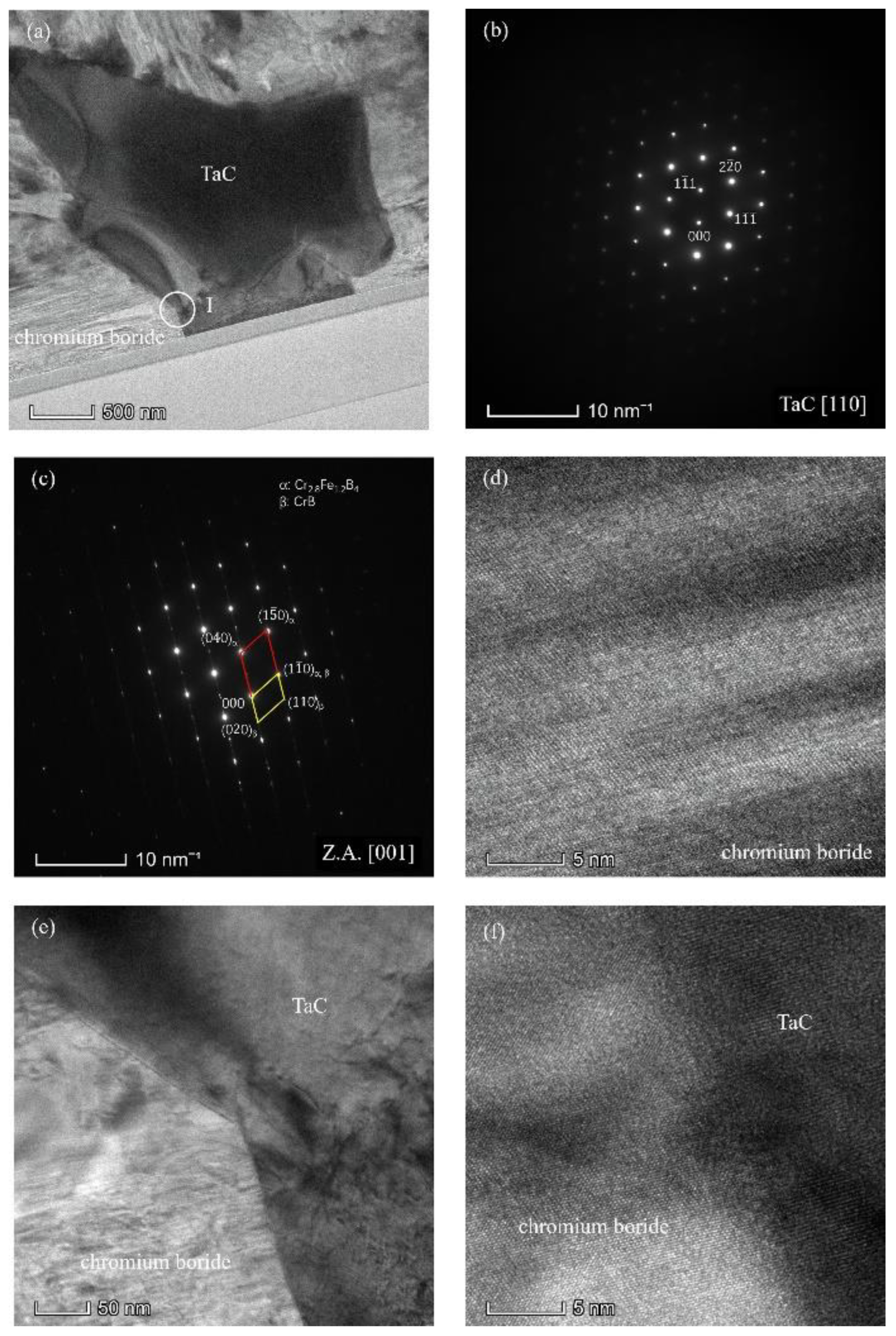
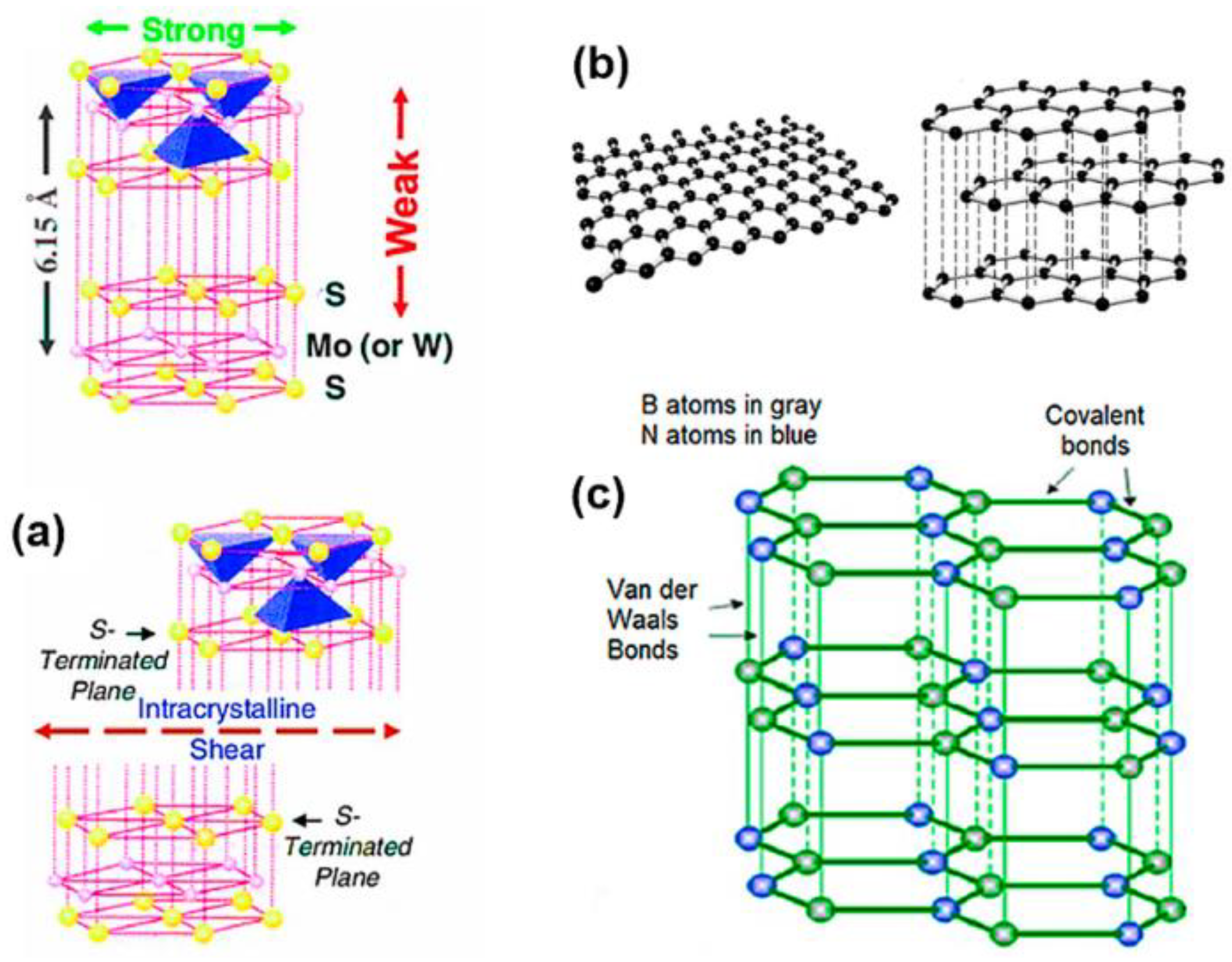


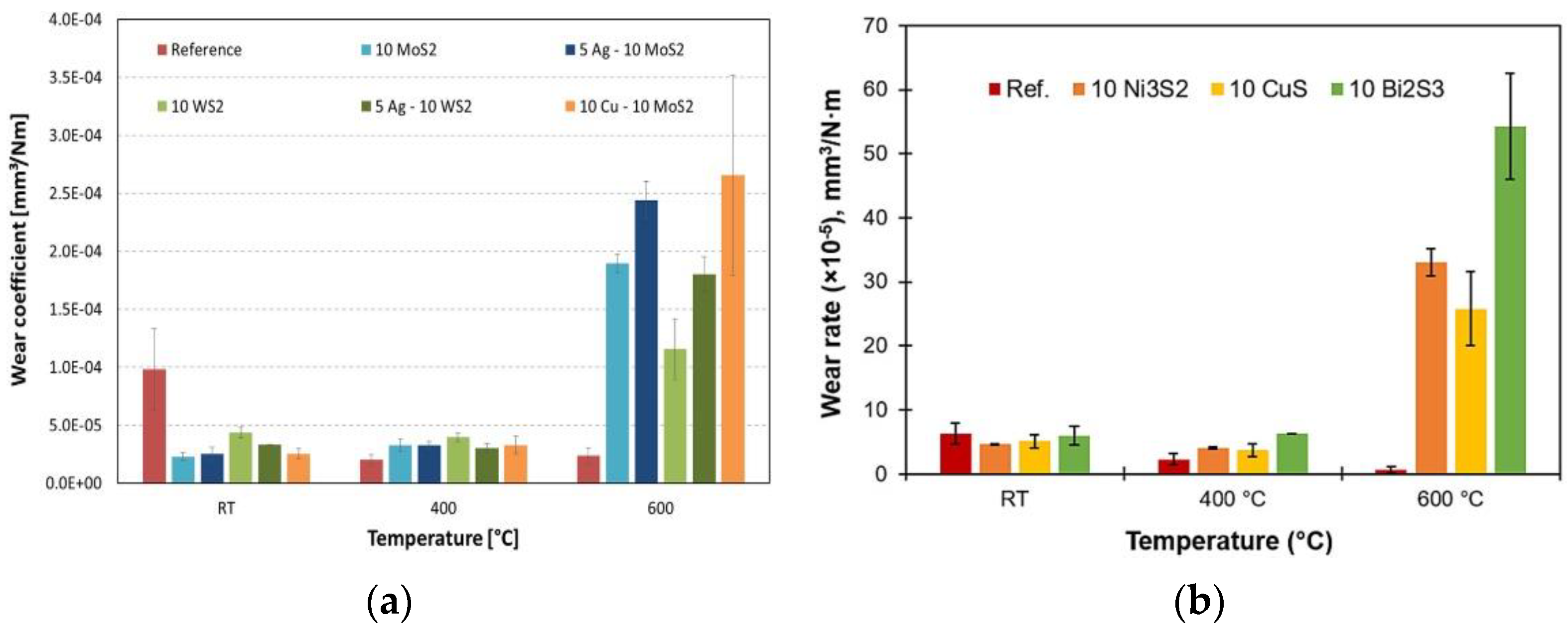
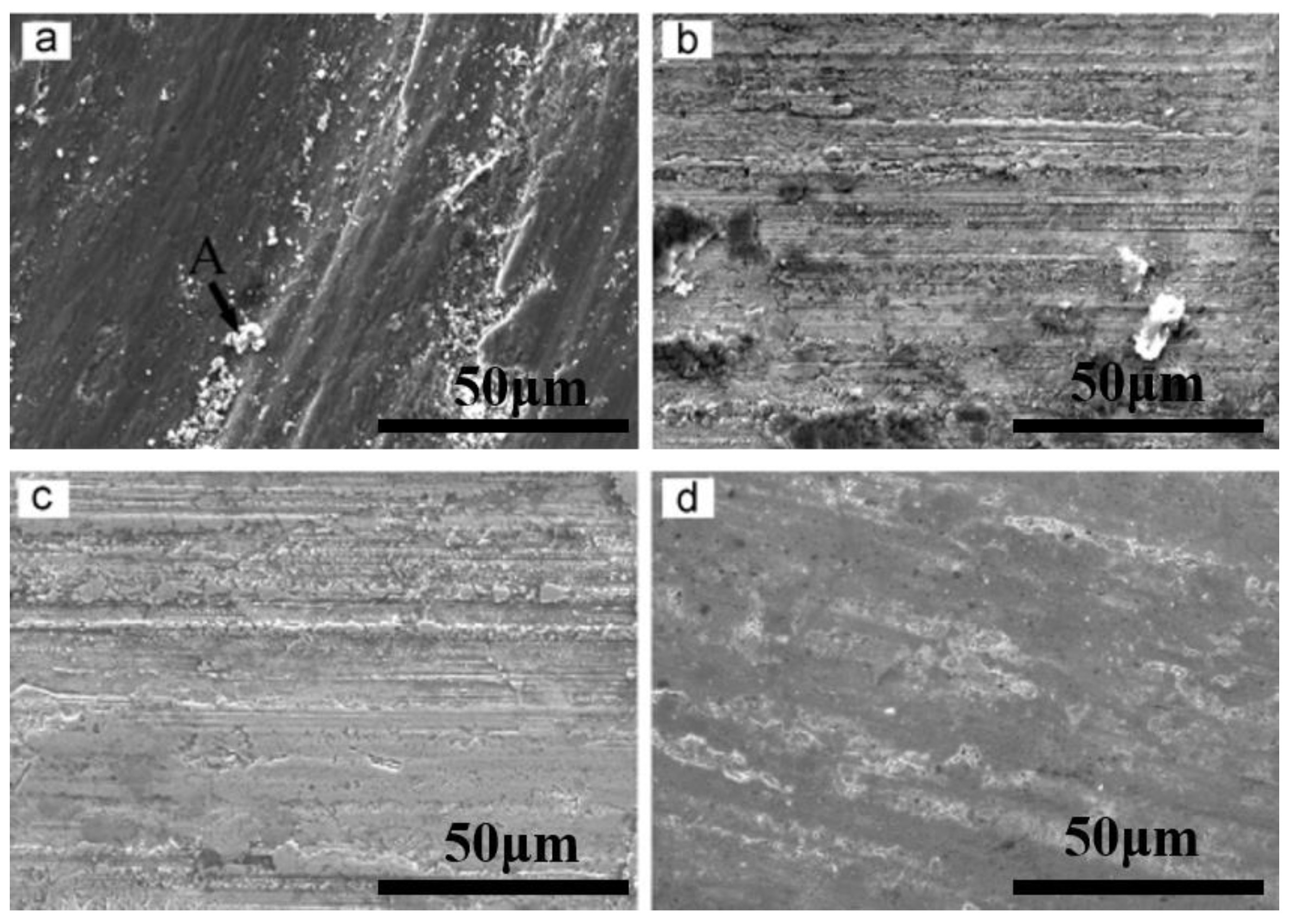
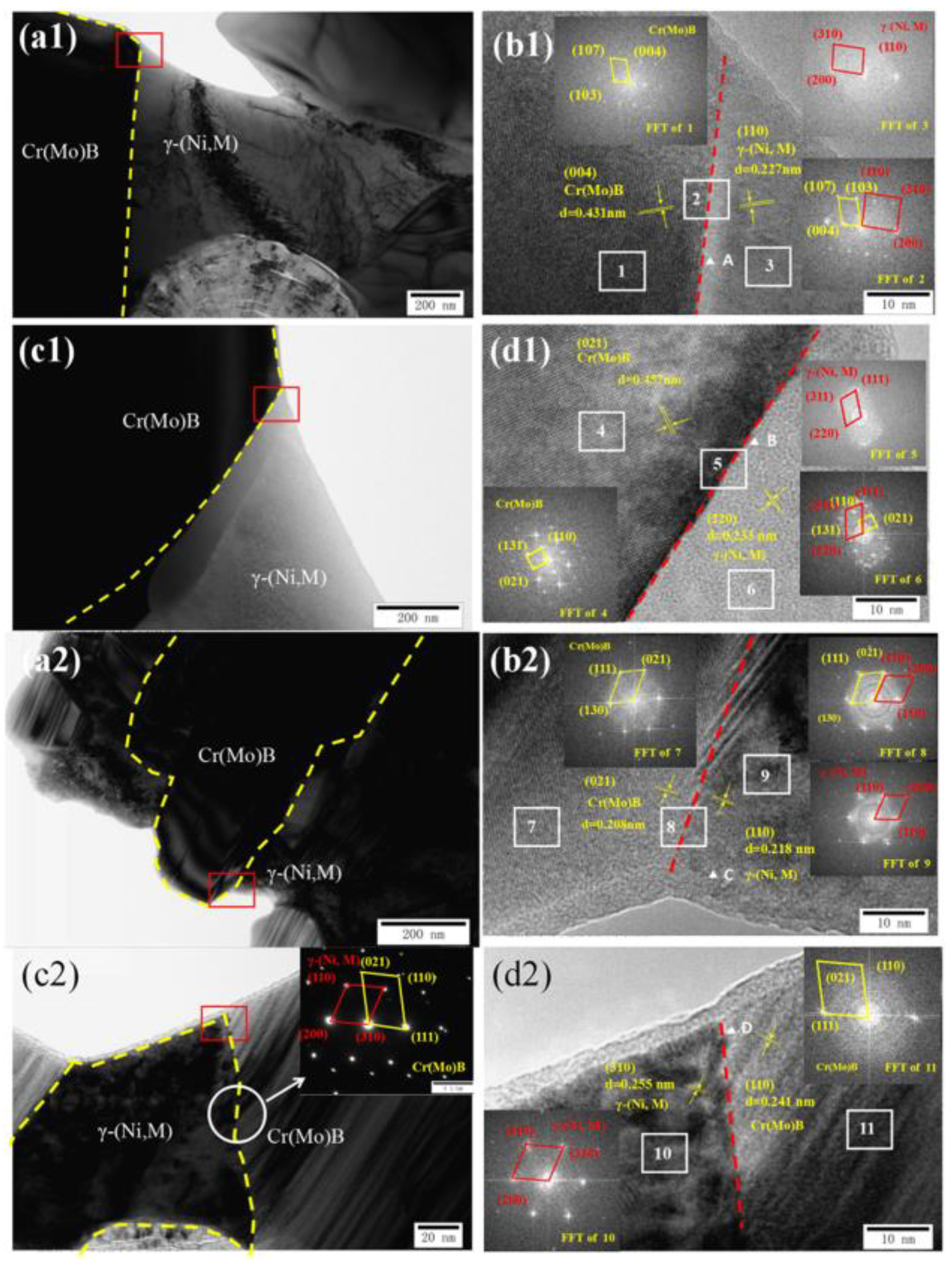
| Ref. | Substrate | Matrix | Ceramic Phase | Key Findings | Tribological Testing Process, Parameters |
|---|---|---|---|---|---|
| Li, 2017 [35] | Ti6Al4V | NiCrBSi | TaC | The addition of TaC obviously refines the microstructure of the coating; the hardness and high temperature wear resistance of the coating are improved | A GHT-1000E high-temperature tribometer; Hard Si3N4 ceramic balls (d = 4 mm); Load: 10 N; Temperature: 600 °C; Tliding speed: 0.188 m/s |
| Yu, 2021 [36] | Medium carbon steel | NiCrBSi | Ta | TaC synthesized in situ has higher hardness and thermal stability, stronger bonding at TaC/substrate intersection | A pin-on-disc tribometer; Al2O3 disk; Load: 90 N; Temperature: 25, 300 °C, 600 and 700 °C; Sliding speed: 790 m m/s; Time: 60 min |
| Yu, 2022 [37] | Inconel 625 Nickel-based alloy | Ni-Al-Cr | Ta, C powder | TaC grains withstand the burden and prevent micro-cutting of debris. Ta inhibits the growth of Al2O3 and accelerates the sintering of the oxide layer, forming a dense oxide layer over the wear surface | A pin-on-disc tribometer; Load: 60 N; Temperatures: RT, 300 °C, 550 °C and 700 °C; Time: 1 h; Sliding speed: 0.105 m/s |
Disclaimer/Publisher’s Note: The statements, opinions and data contained in all publications are solely those of the individual author(s) and contributor(s) and not of MDPI and/or the editor(s). MDPI and/or the editor(s) disclaim responsibility for any injury to people or property resulting from any ideas, methods, instructions or products referred to in the content. |
© 2023 by the authors. Licensee MDPI, Basel, Switzerland. This article is an open access article distributed under the terms and conditions of the Creative Commons Attribution (CC BY) license (https://creativecommons.org/licenses/by/4.0/).
Share and Cite
Liu, Y.; Wang, K.; Fu, H. Improvement of the High Temperature Wear Resistance of Laser Cladding Nickel-Based Coating: A Review. Metals 2023, 13, 840. https://doi.org/10.3390/met13050840
Liu Y, Wang K, Fu H. Improvement of the High Temperature Wear Resistance of Laser Cladding Nickel-Based Coating: A Review. Metals. 2023; 13(5):840. https://doi.org/10.3390/met13050840
Chicago/Turabian StyleLiu, Yingpeng, Kaiming Wang, and Hanguang Fu. 2023. "Improvement of the High Temperature Wear Resistance of Laser Cladding Nickel-Based Coating: A Review" Metals 13, no. 5: 840. https://doi.org/10.3390/met13050840
APA StyleLiu, Y., Wang, K., & Fu, H. (2023). Improvement of the High Temperature Wear Resistance of Laser Cladding Nickel-Based Coating: A Review. Metals, 13(5), 840. https://doi.org/10.3390/met13050840








